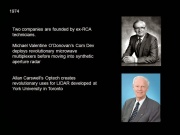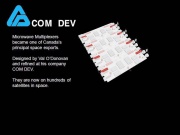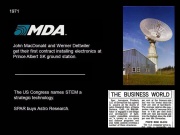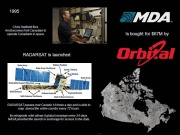100 Years of Aerospace History in Canada: From McCurdy to Hadfield Part 11 by Robert Godwin
From The Space Library
The REAL Story Behind RADARSAT, COM DEV and MDA
SPAR's partners on RADARSAT, COM DEV International (COM DEV) and MacDonald Dettwiler and Associates (MDA), would both play substantial roles in Canada's space engineering future.
COM DEV had been founded by Valentine O'Donovan, an Irish immigrant who had worked at RCA in Montreal. O'Donovan had invented a new type of microwave multiplexer. He and several partners established COM DEV in Dorval, Quebec and quickly built a company with a global presence claiming to have hardware aboard 80% of the world's communication satellites.
In 1974 their first contract was to provide microwave components to SATCOM 1. In April 1979 Donovan announced his intention to move the company and its 100 employees to a four acre site in Cambridge Ontario. In 1985 in their first bid to get involved with the newly proposed space station, COM DEV offered to build a debris detection radar.
COM DEV was subcontracted by SPAR to contribute to the European Remote Sensing Satellite as the supplier of microwave components. Later that year, despite some multi-million dollar contracts, the company was forced to lay off dozens of employees, in part due to a downturn in the industry. By the early 1990s COM DEV still received contracts from the government but they started to shift their focus from project-driven to product-driven.
By 1996 COM DEV had partnered with Motorola to mass produce components for the new low altitude satellite constellation named Iridium. This rapid turnover allowed the company to develop a commercial production strategy it had previously been lacking. By 2013 their sales were $216M with approximately half the sales public and half private. They also received their biggest contract that year, $65M, to provide microwave switchers and multiplexers for a fleet of comm-sats.
MDA was formed in Richmond, British Columbia in 1969 by John S. MacDonald and Werner Dettwiler. Like Lapp, MacDonald had received part of his education at MIT. Dettwiler was a Swiss immigrant who earned his degree at the University of British Columbia.
In 1971 MDA gained a small government contract to supply components to a ground station in Prince Albert, Saskatchewan. The $10M facility at Prince Albert had been opened in June 1959 by Prime Minister Diefenbaker. As a publicity stunt Diefenbaker and President Eisenhower had used the 25m dish to bounce a greeting to each other off the surface of the moon.[i] In 1974 MDA was awarded a $1.3M contract by the Federal government of Canada to build a full prototype ground station for receiving data from weather satellites being operated by NASA and outputting the data to imagery or computer tape.[ii]
All through the mid-1970s MDA concentrated on the impending digital revolution, hiring software and computer engineers. By the late 1970s MDA was exporting world-class processing facilities for Landsat data to places as far afield as, Brazil, Iran, Sweden, Italy, Hong Kong and Australia. By 1978 MDA employed 100 people, with no manufacturing capability, and had sales of $5.5M.[iii]
MDA moved into other technologies including synthetic aperture radar (SAR) and computerized flight planning systems. In 1978 they produced the first digital image using the SAR data from Stehling's Seasat. In the early 1980s the company would have financial difficulty due to over-spending on a job but found financial support from various venture capital companies, as well as the government in Ottawa and Swissair. In 1985 they garnered their first contract with the European Space Agency to provide an SAR system for the European Remote Sensing Satellite. Sales that year were $26M and they employed 450 people.[iv]
In 1987 when SPAR became a prime contractor for Canada's involvement in the International Space Station, MDA was brought on board to handle software needs. That same year was also when SPAR and MDA combined forces on RADARSAT, with MDA providing the SAR and data processing.[v] In July 1992 the shareholders of MDA rejected a $50M buy-out offer from SPAR.
However, in September 1995 MDA was sold to Orbital Sciences Corporation in Dulles for $67M, although the process was approved as a merger rather than a straight takeover, MDA became a wholly owned subsidiary of Orbital.[vi] In March 1999 MDA purchased SPARs robotics division, and with it the Canadarm contracts.[vii] That same year Orbital sold its interests in MDA.
MDA would go from strength to strength, acquiring other companies with skills in robotics and sensing. By 2008 MDA had its hands in insurance, land titles and mortgages and were being allocated almost half of the CSA budget, with contracts worth $430M.
At that time, Alliant Techsystems Inc. (ATK) of Arlington Virginia attempted to purchase MDA but the takeover was blocked by the government in Ottawa. A schism developed between the original founders, with MacDonald issuing dire warnings that MDA wouldn't survive if it couldn't penetrate the veil of US government contracts, while Vern Dettwiler expressed his desire that the company not become an arm of a foreign defense contractor.
The government held fast on their decision and the deal was stymied. However, only four years later MDA purchased Palo Alto, California based Space System/Loral (SS/L) for $875M, transforming John MacDonald and Vern Dettwiler's little start-up into a global giant in space technology with access to US government contracts.
In 2005 work began on a replacement and upgrade to the RADARSAT which had been on orbit since 1995. In 2007 RADARSAT-2, built by MDA, took over, but a new RADARSAT constellation is now slated to fly in 2018. This will consist of at least three and possibly as many as six RADARSATS, designed to keep a close eye on Canada's northern waters.
Footnotes
[i] Ibid. Jun 8 1959
[ii] Ibid. Dec 28 1974
[iii] Ibid. Dec 9 1978
[iv] Ibid. Dec 27 1985
[v] Ibid. Jun 26 1987
[vi] Ibid, Sept 6 1995
[vii] Ibid. Mar 20 1999




